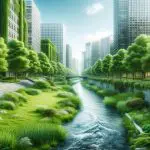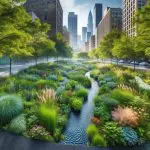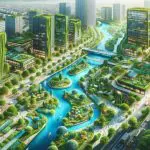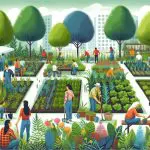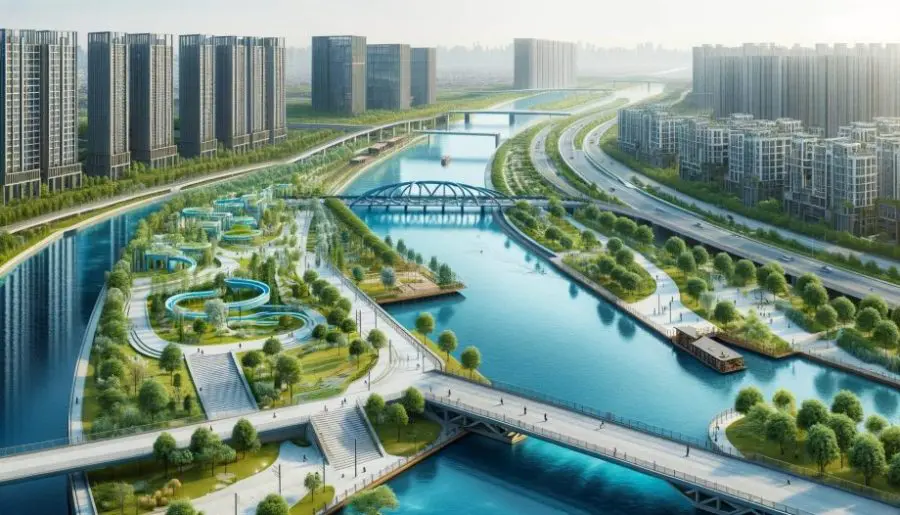
Dive into understanding what is blue infrastructure, its role in urban sustainability, and its impact on our cities. A fresh take on water management!
What Is Blue Infrastructure? Key Takeaways:
- What is blue infrastructure?
- It refers to water-based elements within urban environments
- This includes natural bodies like rivers, lakes, and ponds
- And engineered structures such as canals and stormwater systems.
- It plays a crucial role in sustainable urban planning, enhancing both ecological health and city living.
Ever wondered what is blue infrastructure and why it’s making waves in urban planning?
It’s all about blending nature with city life, focusing on water elements that shape our urban landscapes.
Join us as we explore this fascinating world where rivers, lakes, and man-made wonders come together for a sustainable future.
What Is Blue Infrastructure?
Blue infrastructure refers to urban infrastructure related to water management.
It is often associated with green infrastructure in urban environments and can include natural water features like rivers, ponds, lakes, and man-made elements such as harbors, quays, and piers.
Blue infrastructure plays a key role in supporting unique aquatic biodiversity in urban areas and can have significant health and well-being benefits for populations with access to these blue spaces.
Blue space (also referred to as blue infrastructure) in urban planning and design comprises all the areas dominated by surface waterbodies or watercourses. In conjunction with greenspace (parks, gardens, etc. specifically: urban open space), it may help in reducing the risks of heat-related illness from high urban temperatures (urban heat island). Substantial urban waterbodies naturally exist as integral features of the geography of many cities because of their historical development, for example the River Thames in London. Wikipedia
What Is Blue-Green Infrastructure?
Blue-green infrastructure is a network of natural and semi-natural spaces designed to manage water sustainably while offering multiple societal benefits.
It combines blue, or aquatic elements (e.g., rivers, ponds, wetlands), with green, or terrestrial elements (e.g., trees, plants), in urban design.
This type of infrastructure moves away from traditional Gray infrastructure, like concrete drains and pipelines, and instead uses nature-based systems that replicate natural water-management processes.
This approach helps alleviate the pressure on conventional drainage systems and enhances city sustainability and resilience.
Components of Blue-green Infrastructure
Components of blue-green infrastructure include blue elements like rivers, ponds, and wetlands that are crucial for the urban water cycle, and green elements like trees, parks, and gardens that contribute to air quality and biodiversity.
This infrastructure addresses urban challenges like flood resilience, climate change impact, and environmental degradation.
Economically, it tends to be more cost-effective in the long run compared to traditional infrastructure.
Socially, it enhances the quality of life by providing green open spaces for recreation and fostering community engagement.
What Is Gray Infrastructure?
Ever wondered about the backbone of our urban landscapes? It’s the traditional city framework of concrete and steel.
From skyscrapers to highways, this post uncovers the essentials of gray infrastructure and its role in shaping our urban environments.
Introduction to Blue Infrastructure
Have you ever wondered what blue infrastructure is? It’s an essential part of our urban environment, focusing on water-related elements.
In this post, we’ll explore what blue infrastructure means, its components, and how it differs from green and Gray infrastructure. Get ready to dive into the world of sustainable urban design!
Blue infrastructure is a key component in modern urban design, focusing on managing water sustainably within our cities.
From rivers to man-made harbors, it encompasses various elements that play a crucial role in enhancing urban life.
Let’s explore the intricate world of blue infrastructure and its significance in our daily lives.
- What Blue Infrastructure Encompasses
- Blue infrastructure includes natural water features like rivers, lakes, and ponds, as well as man-made elements such as harbors, quays, and piers.
- These elements are integral in managing urban water cycles and supporting aquatic biodiversity.
- Comparison with Green and Gray Infrastructure
- Unlike green infrastructure, which involves land-based elements like parks and gardens for air quality and biodiversity, blue infrastructure focuses on water-related aspects.
- Gray infrastructure, on the other hand, refers to traditional urban development using concrete and steel, often lacking the environmental benefits of blue and green infrastructures.
- Role in Urban Planning
- In urban planning, blue infrastructure is crucial for stormwater management, reducing flood risks, and enhancing the recreational and aesthetic value of urban areas.
- It supports a sustainable urban ecosystem, balancing human activities with natural water management.
Here’s a table summarizing the key differences between blue, green, and Gray infrastructure:
| Infrastructure Type | Description | Key Elements |
|---|---|---|
| Blue Infrastructure | Focuses on water-based urban elements | Rivers, lakes, harbors, quays, piers |
| Green Infrastructure | Involves terrestrial, vegetation-based elements | Parks, gardens, green roofs, urban forests |
| Gray Infrastructure | Traditional urban construction with concrete and steel | Roads, bridges, buildings, concrete drainage |
This table provides a clear distinction between the three types of infrastructure, each playing a unique role in urban planning and development.
Understanding Blue Infrastructure
Definition and Components of Blue Infrastructure
Blue infrastructure is primarily concerned with the water elements in an urban setting.
It includes both natural and engineered features designed to manage and utilize water resources effectively.
Key components of blue infrastructure involve:
- Natural Water Bodies: This includes rivers, lakes, and ponds, which are integral to the natural landscape of a city.
- Engineered Water Features: Man-made structures such as harbors, quays, and piers, which are designed for various purposes like transportation, recreation, and flood control.
- Stormwater Management Systems: These are engineered solutions to manage excess rainwater, helping to prevent flooding and waterlogging in urban areas.
Examples of Blue Infrastructure
Blue infrastructure can be seen in various forms in urban landscapes. Some examples include:
- Rivers and Lakes: Often central to city layouts, providing natural beauty and recreational spaces.
- Urban Ponds: Smaller water bodies that can be both aesthetic and functional in managing urban water.
- Harbors and Quays: Vital for maritime transport and often developed into recreational and commercial areas.
- Flood Management Structures: Like retention basins and constructed wetlands, these help manage excess water during heavy rains.
Role in Supporting Aquatic Biodiversity
Blue infrastructure plays a crucial role in supporting biodiversity within urban areas:
- Habitat for Aquatic Life: Natural water bodies serve as habitats for various species of fish, amphibians, and waterfowl.
- Promoting Biodiversity: Engineered features like wetlands can be designed to create diverse ecosystems that support a wide range of species.
- Connecting Green Spaces: Water bodies often link different green spaces, creating ecological corridors for wildlife.
Health and Wellbeing Benefits of Blue Spaces for Urban Populations
The presence of blue infrastructure in cities offers significant health and wellbeing benefits:
- Mental Health Benefits: Studies have shown that proximity to water bodies can reduce stress and improve mental health.
- Recreational Opportunities: Blue spaces provide areas for activities like walking, cycling, and boating, promoting physical health.
- Social Spaces: Waterfronts are popular gathering places, encouraging community interaction and cohesion.
- Environmental Education: These spaces provide opportunities for learning about ecology and sustainability.
Understanding Blue Infrastructure Table: Types of Blue Infrastructure
| Type | Description | Examples |
|---|---|---|
| Natural Water Bodies | Natural water features in urban settings | Rivers, Lakes, Ponds |
| Engineered Water Features | Man-made structures designed for water management | Harbours, Quays, Piers |
| Stormwater Management Systems | Systems to manage urban water overflow | Rain Gardens, Permeable Pavements |
In a Nutshell:
In summary, blue infrastructure is more than just a functional element of urban design; it’s a crucial component for biodiversity, recreation, and well-being in our cities.
By integrating water management with ecological and social needs, blue infrastructure contributes significantly to making urban environments more livable and sustainable.
The Concept of Blue-Green Infrastructure
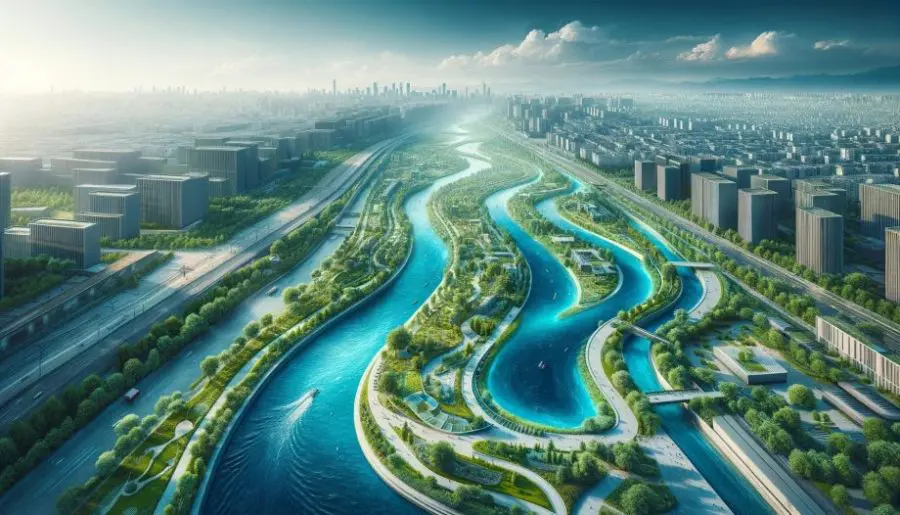
Definition Blue-Green Infrastructure
Blue-green infrastructure represents a holistic approach to urban planning, combining elements of both blue (water-based) and green (land-based) infrastructures.
It’s an integrated network of natural and man-made systems designed to manage water resources and provide ecological services in urban areas.
This concept extends beyond mere water management to include the creation and maintenance of green spaces, such as parks and green roofs, alongside aquatic features like rivers and ponds.
Integration of Blue (Aquatic) and Green (Terrestrial) Elements in Urban Design
The integration of blue and green elements in urban design is a strategic approach to enhance environmental sustainability and urban resilience. This includes:
- Water-Sensitive Urban Design: Incorporating features like rain gardens, bioswales, and permeable pavements that help in managing stormwater.
- Creating Green Spaces: Development of parks, urban forests, and green corridors that provide habitats for wildlife and recreational spaces for residents.
- Linking Water and Land: Designing urban landscapes where water bodies are connected with green spaces, creating a seamless natural environment within urban settings.
Contrast with Traditional Gray Infrastructure
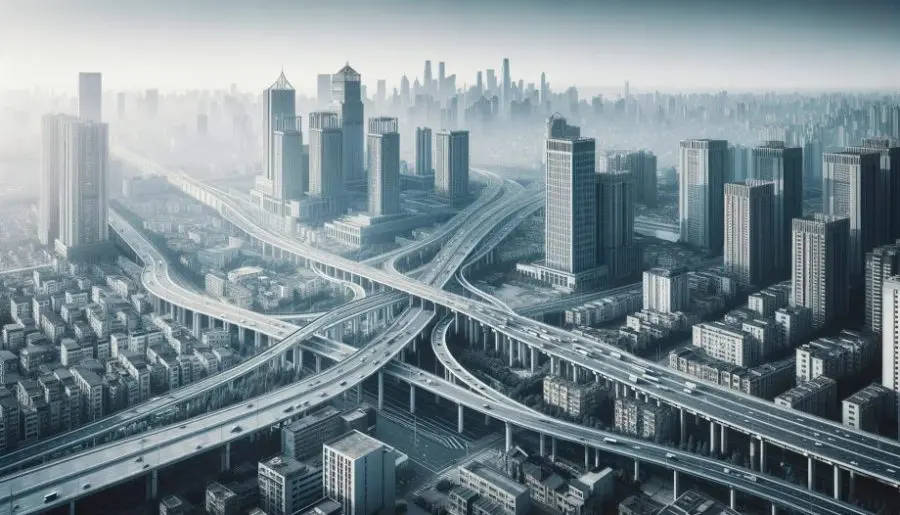
Blue-green infrastructure stands in stark contrast to traditional Gray infrastructure:
- Sustainability: Unlike Gray infrastructure, which often focuses solely on functionality (like roads, buildings, and concrete sewers), blue-green infrastructure emphasizes sustainability and environmental compatibility.
- Flexibility and Adaptation: Gray infrastructure is typically rigid and less adaptive to changing environmental conditions, whereas blue-green infrastructure is more flexible and can evolve over time.
- Ecosystem Services: Blue-green infrastructure provides additional benefits such as biodiversity conservation, air and water purification, and carbon sequestration, which are not typically offered by Gray infrastructure.
The Importance of Nature-Based Systems in Urban Water Management
Nature-based systems are at the core of blue-green infrastructure and play a vital role in urban water management:
- Natural Water Filtration: Utilizing natural processes to filter and purify water, reducing the load on artificial water treatment systems.
- Flood Mitigation: Through the absorption and gradual release of water, blue-green infrastructure can significantly reduce the risk and impact of urban flooding.
- Climate Adaptation: These systems offer a resilient approach to handling extreme weather events and changing climate patterns, helping cities adapt more effectively to environmental changes.
The Concept of Blue-Green Infrastructure Table: Benefits of Blue-Green Infrastructure
| Benefit Type | Description |
|---|---|
| Environmental | Improved biodiversity, natural water purification |
| Social | Enhanced recreational spaces, community cohesion |
| Economic | Increased property value, reduced infrastructure costs |
In a Nutshell:
In essence, blue-green infrastructure is an innovative approach to urban development, blending the best of natural and engineered systems to create sustainable, resilient, and livable cities.
This approach not only addresses the practical aspects of urban living but also enhances the quality of life by bringing nature closer to urban residents.
Components and Benefits of Blue-Green Infrastructure
Detailed Look at Blue Elements: Rivers, Ponds, and Wetlands
Blue elements of blue-green infrastructure are essential for water management and ecosystem services in urban areas.
- Rivers: Act as natural drainage channels, support diverse aquatic life, and are central to many urban landscapes for both ecological and recreational purposes.
- Ponds: Small yet significant, ponds contribute to local biodiversity, provide habitats for various species, and can play a role in urban cooling.
- Wetlands: Known as natural water filters, wetlands are crucial for water purification, flood control, and providing habitats for a wide range of wildlife.
Overview of Green Elements: Trees, Parks, and Gardens

Green elements complement the blue components and are vital for urban environmental health.
- Trees: Essential for air purification, carbon sequestration, and providing shade. Urban trees also contribute to the aesthetic value of cities and can reduce the urban heat island effect.
- Parks: Serve as green lungs for cities, offering recreational spaces for residents and habitats for urban wildlife. They also play a role in improving mental and physical health among city dwellers.
- Gardens: Including both private gardens and public green spaces, these areas contribute to urban biodiversity, help in cooling the environment, and provide spaces for community interaction and relaxation.
Contribution to the Urban Water Cycle, Air Quality, and Biodiversity
Blue-green infrastructure plays a significant role in enhancing urban environments by:
- Improving the Urban Water Cycle: These systems help in managing stormwater, reducing runoff, and replenishing groundwater.
- Enhancing Air Quality: Green elements like trees and gardens act as natural air filters, absorbing pollutants and providing cleaner air.
- Boosting Biodiversity: By providing various habitats, blue-green infrastructure supports a wide range of plant and animal species within urban areas.
Addressing Urban Challenges: Flood Resilience, Climate Change, and Environmental Degradation
Blue-green infrastructure is key to addressing several critical urban challenges:
- Flood Resilience: By absorbing excess water during heavy rains, these systems can significantly reduce the risk and impact of urban flooding.
- Climate Change Mitigation: Through carbon sequestration and providing cooling effects, blue-green infrastructure helps cities adapt to and mitigate the effects of climate change.
- Combating Environmental Degradation: By introducing natural elements into urban settings, these systems help restore ecological balance and reduce environmental degradation.
Table: Components of Blue-Green Infrastructure
| Component | Role in Urban Environment |
|---|---|
| Blue Elements (e.g., rivers, ponds) | Water management, habitat for aquatic life |
| Green Elements (e.g., trees, parks) | Air purification, recreational spaces |
In a Nutshell:
In summary, the combined effect of blue and green elements in urban planning not only addresses critical environmental issues but also enhances the quality of life for urban residents, creating more sustainable, resilient, and livable cities.
Economic and Social Advantages
Cost-Effectiveness of Blue-Green Infrastructure Compared to Traditional Infrastructure
Blue-green infrastructure is increasingly recognized for its cost-effectiveness compared to traditional, Gray infrastructure.
- Reduced Construction Costs: Implementing blue-green infrastructure often involves lower initial costs than traditional infrastructure due to the use of natural systems.
- Long-term Savings: Maintenance costs for natural landscapes and water systems can be lower than for concrete and steel structures. Additionally, blue-green infrastructure can reduce the need for expensive flood defense systems.
- Mitigating Climate Change Impacts: These systems play a crucial role in adapting to climate change, potentially saving cities significant costs related to weather-related damages.
Enhancement of Property Values and Economic Uplift in Urban Areas
The introduction of blue-green infrastructure can positively impact local economies.
- Property Value Increase: Properties near green spaces and water bodies often have higher values. This can lead to increased tax revenues for cities.
- Economic Development: Green spaces and water features attract businesses and tourists, boosting local economies.
- Job Creation: The development and maintenance of blue-green infrastructure can create new jobs in sectors like landscaping, environmental management, and tourism.
Quality of Life Improvements: Recreational Spaces and Community Engagement

Blue-green infrastructure significantly enhances the quality of life for urban residents.
- Recreational Opportunities: Access to parks, rivers, and lakes supports physical activities such as walking, biking, and water sports, promoting healthier lifestyles.
- Mental Health Benefits: Studies have shown that access to natural spaces can reduce stress and improve mental well-being.
- Social Cohesion: Green and blue spaces often serve as communal areas where people can gather, fostering a stronger sense of community and belonging.
- Educational Value: These environments offer educational opportunities for residents to learn about ecology, sustainability, and the importance of preserving natural habitats.
Global Examples and Case Studies
Highlighting Successful Implementations in Cities Worldwide
Blue and blue-green infrastructure projects have been implemented worldwide with notable success. These examples highlight the diverse applications and benefits of such infrastructure in urban environments.
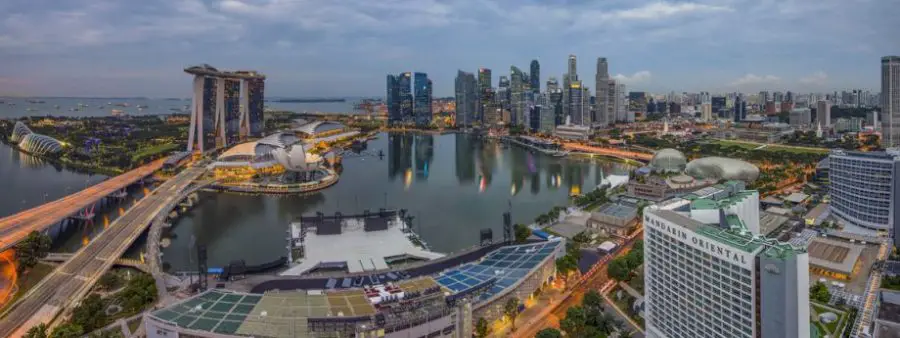
- Singapore’s Waterfront Development:
- Approach: Singapore has embraced blue infrastructure through its extensive waterfront development, integrating waterways and green spaces seamlessly.
- Outcome: This has not only beautified the city but also improved flood resilience and created recreational spaces for residents.
- Copenhagen’s Harbour Baths, Denmark:

-
- Approach: Copenhagen transformed its harbor into a clean and vibrant public space with facilities for swimming and recreation.
- Outcome: This project demonstrates how blue infrastructure can revitalize urban areas, enhancing both environmental quality and public life.
- New York City’s High Line, USA:

-
- Approach: An example of green infrastructure, the High Line is a linear park built on a historic freight rail line elevated above the streets of Manhattan.
- Outcome: It’s a green oasis in the city, boosting local real estate values and offering a unique recreational experience.
- Melbourne’s Urban Forest Strategy, Australia:
- Approach: This green infrastructure initiative aims to increase the city’s green cover significantly.
- Outcome: By enhancing urban greenery, Melbourne is improving air quality, reducing urban heat island effects, and enhancing biodiversity.
- Rotterdam’s Water Square, Netherlands:
- Approach: Combining both blue and green elements, the Water Square in Rotterdam is designed to store rainwater and reduce flooding.
- Outcome: It serves as a public space during dry periods and a water storage facility during heavy rains, showcasing multifunctional urban design.
Discussing the Unique Approaches and Outcomes
These case studies reveal the innovative and adaptable nature of blue and blue-green infrastructure.
They demonstrate the potential to transform urban areas into more sustainable, livable, and resilient environments.
By integrating natural elements into city planning, these projects offer valuable lessons in addressing contemporary urban challenges like climate change, urban heat islands, and the need for recreational spaces.
Each project reflects a unique approach tailored to its specific urban context, highlighting the versatility and effectiveness of blue and blue-green infrastructure in urban development.
Future Perspectives and Challenges

The Evolving Role of Blue and Blue-Green Infrastructure in Urban Planning
Blue and blue-green infrastructure is becoming increasingly vital in urban planning, shaping the future of cities around the world.
- Focus on Resilience and Sustainability: Cities are recognizing the importance of these systems in building resilience against climate change and promoting environmental sustainability.
- Integrating with Urban Development: There’s a growing trend to incorporate blue and green spaces in urban development projects, considering them not just as add-ons but as essential components of urban design.
Technological Advancements and Policy Shifts Influencing Implementation
The implementation of blue and blue-green infrastructure is being influenced by technological advancements and policy changes.
- Smart Technology: Innovations in technology, such as IoT (Internet of Things) and AI (Artificial Intelligence), are being used to monitor and manage water systems more efficiently.
- Policy Support: Governments and urban planners are increasingly creating policies that encourage the development of blue and green spaces. This includes incentives for green building practices and investments in public green spaces.
Challenges in Integrating These Infrastructures into Urban Landscapes
Despite the benefits, there are challenges in integrating blue and blue-green infrastructure into existing urban landscapes.
- Space Constraints in Dense Urban Areas: In highly urbanized areas, finding space for blue and green infrastructure can be challenging.
- Balancing Development and Preservation: There’s often a delicate balance between urban development and the preservation of natural spaces.
- Funding and Maintenance: Securing funding for the development and ongoing maintenance of these infrastructures can be a significant hurdle.
- Public Awareness and Engagement: Encouraging public support and understanding the value of these spaces is crucial for their success and longevity.
In a Nutshell:
As urban areas continue to evolve, the integration of blue and blue-green infrastructure will play a critical role in shaping sustainable, resilient, and livable cities.
Overcoming these challenges will require innovative approaches, collaborative efforts, and a commitment to sustainable urban development.
FAQs: Understanding What Is Blue Infrastructure and Green, and Gray Infrastructure
Let’s explore some frequently asked questions to better understand the concepts of blue, green, and Gray infrastructure and their roles in urban environments.
Q: What is meant by blue infrastructure?
A: Blue infrastructure refers to water-based elements in urban settings.
This includes natural bodies like rivers, lakes, and ponds, and man-made structures such as dams, canals, and stormwater systems.
Q: What is the difference between blue and green infrastructure?
A: Blue infrastructure is focused on managing water elements, while green infrastructure involves land-based, vegetation-focused elements like parks, gardens, and green roofs.
Blue infrastructure deals with water management and aquatic ecosystems, whereas green infrastructure is about creating and maintaining terrestrial green spaces.
Q: What are the elements of blue-green infrastructure?
A: Blue-green infrastructure combines elements of both blue and green infrastructures.
This includes water bodies (rivers, lakes), water management systems (wetlands, bioswales), and green spaces (parks, urban forests, green roofs).
Q: What is blue-green and Gray infrastructure?
A: Blue-green infrastructure refers to a mix of natural water systems and green spaces, focusing on sustainability and environmental benefits.
Gray infrastructure is the traditional urban development using concrete and steel, like roads and buildings, often lacking environmental advantages.
Q: What are examples of green and blue infrastructure?
A: Examples of green infrastructure include urban parks, green roofs, and community gardens. Blue infrastructure examples are riverside walks, stormwater ponds, and constructed wetlands.
Q: What does Gray infrastructure mean?
A: Gray infrastructure refers to the conventional built environment in urban areas, primarily composed of concrete and steel.
This includes roads, bridges, buildings, and traditional sewer systems, focusing on functionality rather than sustainability or environmental integration.
Conclusion: Embracing a Sustainable Future with Blue and Blue-Green Infrastructure
Summarizing the Importance
Blue and blue-green infrastructures are not just design elements; they are essential components for sustainable urban development.
These nature-based solutions blend seamlessly with natural environments to enhance urban resilience, biodiversity, and the well-being of urban populations.
By integrating water management with green spaces, cities can address critical challenges like climate change, urban heat islands, and environmental degradation, making urban areas more livable, sustainable, and resilient.
The Impact on Sustainable Urban Development
These infrastructures play a pivotal role in shaping the future of urban landscapes.
They offer a sustainable alternative to traditional Gray infrastructure, reducing environmental footprints while enhancing the quality of urban life.
Cities that adopt these systems demonstrate a commitment to environmental stewardship and a forward-thinking approach to urban planning.
Call to Action
We encourage readers to become advocates for and participants in local blue-green infrastructure initiatives.
Whether it’s supporting local policies, volunteering in community green spaces, or simply spreading awareness about the importance of these systems, every effort counts.
By getting involved, you can help create a sustainable future for your community and urban environments worldwide.
Your support and involvement can drive the change towards more sustainable, resilient, and vibrant cities.
Let’s work together to make our urban spaces greener, bluer, and better for future generations.

